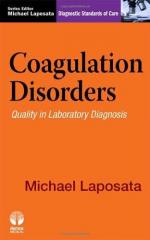|
This section contains 609 words (approx. 3 pages at 300 words per page) |

|
Hypercoagulation disorders (or hypercoagulable states or disorders) have the opposite effect of the more common coagulation disorders. In hypercoagulation, there is an increased tendency for clotting of the blood, which may put a patient at risk for obstruction of veins and arteries (phlebitis or pulmonary embolism).
In normal hemostasis, or the stoppage of bleeding, clots form at the site of the blood vessel's injury. However, in hypercoagulation, clots develop in circulating blood. This disorder can cause clots throughout the body's blood vessels, sometimes creating a condition known as thrombosis. Thrombosis can lead to infarction, or death of tissue, as a result of blocked blood supply to the tissue. However, hypercoagulability does not always lead to thrombosis. In pregnancy, and other hypercoagulable states, the incidence of thrombosis is higher than that of the general population, but is still under 10%. However, in association with certain genetic disorders, hypercoagulation...
|
This section contains 609 words (approx. 3 pages at 300 words per page) |

|


